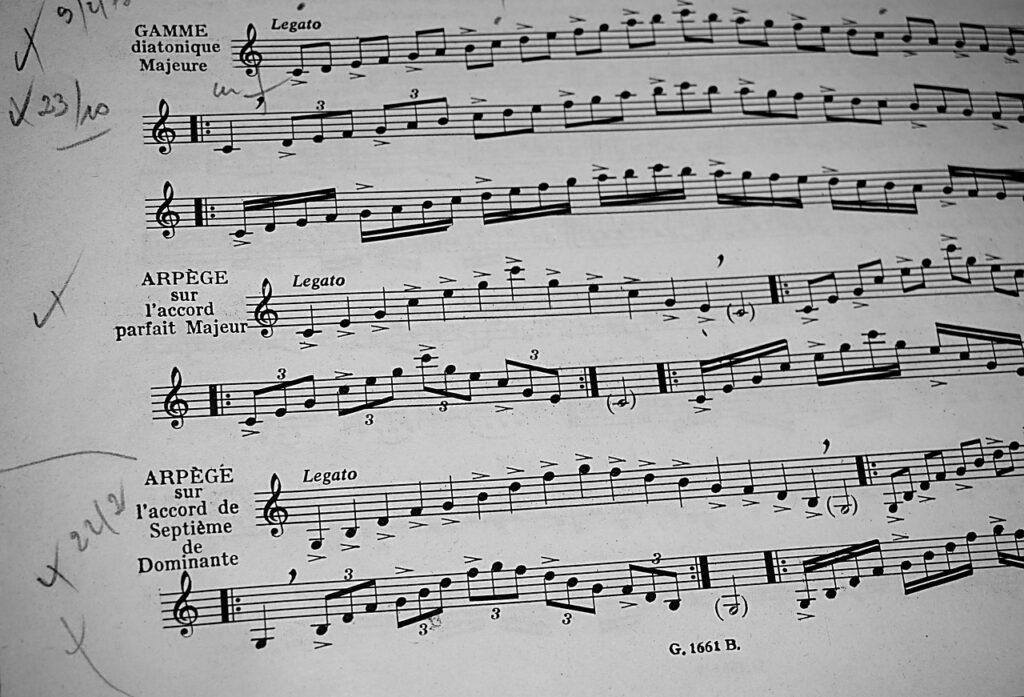Estimated reading time 3 minutes
Table of Contents
Introduction: What Are the Small “>” Signs Above or Below the Notes?
What are the small “>” signs above or below the notes? We call them and other signs like them articulations of force. Read on to learn what they tell us to do when we see them in sheet music.
This post uses musical terms. See the Glossary at the end of the article for links to definitions.

Explaining What the Small “>” Signs Above or Below the Notes Are
Mobile users: for best results reading the music, tilt your screen 90o to the right.
![What is the small [accent] sign above or below the note - Accent, Tenuto, Marcato line 1](https://successmusicstudio.com/wp-content/uploads/2023/02/What-is-the-small-accent-sign-above-or-below-the-note-Accent-Tenuto-Marcato-line-1-1024x140.png)
What are the small “>” signs above or below the notes? We call them accent signs (>).
- Both accents and dynamics show us how loud to play the music in the score. They just do it in different ways.
- Dynamic signs (f = forte = loud, mf = mezzo forte = medium loud, p = piano = soft, etc.) effect large blocks of notes.
- Whereas an accent sign over or under a note makes only that one note or chord louder.
The accent sign looks like a great-than sign from math.
- Mnemonic: play the note with a force greater than you would without the accent.
- This will help you remember the symbol’s name and function.
- Look at the example above, you can see a down-stem has the accent over the staff.
- Likewise, when you have an up-stem note, the accent goes below the staff.
When grouped with other similar signs, we call them articulations of force.
- Tenuto, accents, and marcato signs make up this category.
- The example above shows how the articulations of force get ordered from quietest to loudest.
- The unmarked note will be the quietest and the marcato note will be the loudest.
In addition, how we interpret the accents depends on the dynamics.
- Look at the example below. Piano (p) with an accent tells you to play a little louder than soft.
- Forte (f) with an accent tells you to play a little louder than loud.
- You can get even more subtle loudness shadings with the dynamics when you use tenuto and marcato as well.
When you consider sforzando (sf), sforzato (sfz), and forzando (fz) it just starts to get crazy. (See the Glossary for definitions of these terms.)
![What is the small [accent] sign above or below the note - Accent, Tenuto, Marcato line 2](https://successmusicstudio.com/wp-content/uploads/2023/02/What-is-the-small-accent-sign-above-or-below-the-note-Accent-Tenuto-Marcato-line-2-1024x114.png)
Concluding Thoughts to “What Are the Small “>” Signs Above or Below the Notes?”
Well, that explains what the small “>” signs above or below the notes are.
Dynamics, tenuto, accents, and marcato signs all add an extra dimension to the music. Why is that important?
- Imagine your math teacher doing a lecture.
- If he talked only at one volume, it’d make his seminar so boring you’d fall asleep.
- However, if he varies the tone and volume of his voice, that alone will make his lecture much more interesting to listen to.
- Likewise, if you play your music at only one volume, you’ll bore your audience to sleep.
Effective use of dynamics and the articulations of force will keep your listeners interested and engaged.
If you have a hard time playing accents, try color coding them:
Now go play something and have some fun!
Related Content:
- How Does Your Brain Learn to Play the Piano with Two Hands?
- Ways Around the Difficulty of Playing the Piano Due to Short Fingers and Small Hands
- How to Overcome the Fear of Performing in Front of an Audience
- Why It’s So Hard for Someone with a Good Ear to Learn Sheet Music
- Why Do Minor Keys Sound Sad to Me?
- Do I Really Have to Learn Music Theory to Learn How to Play Piano?
- Why Do Pianists Occasionally Play Their Hands at Different Times as They Perform
- After They Can Sight-Read What’s Left for Musicians to Learn?
© 2023 Geoffrey Keith
Join me for in-person or online lessons today!
Back to the All-Purpose Music Tips and Topics category blogs page
Glossary
I’d Like to Know the Meaning of the Word Cadence [Video]
“I’d like to know the meaning of the word cadence. How does it differ in language vs music?” Candence in music and language both have to do with regulating the flow of sound. However, even though the definitions are related, they’re not the same. Keep reading to learn more. Estimated reading time 3 minutes.
Read MoreHow to Sing R-Controlled Vowels in English
Do you need help singing words with sustained “R” sounds? Did you know that “R” is actually a vowel? However, it’s very closed, so you need special techniques when producing R-controlled vowels. Keep reading “How to Sing R-Controlled Vowels in English” to have a guide to how it works. Estimated reading time 3 minutes.
Read MoreWhy Do Minor Keys Sound Sad to Me?
Have you ever wondered, “Why do minor keys sound sad and major keys sound happy?” Has this phenomenon been hardwired into us, or does culture impact how we perceive scales? In fact, it’s a little bit of both. Read more to learn how this works. Estimated reading time 3 minutes.
Read MoreGeoff will Have a Table at the 2023 Special Needs Resource Fair
I‘ll have a table at LexSEPTA’s 2023 Special Needs Resource Fair this Saturday. I will have my Perception Presentation with me, which shows what it’s like to have a learning disability, such as dyslexia or language-based learning disability. See you there!
Read More

![I’d Like to Know the Meaning of the Word Cadence [Video] - Triangle](https://successmusicstudio.com/wp-content/uploads/2024/05/Id-Like-to-Know-the-Meaning-of-the-Word-Cadence-Video-Triangle-300x169.jpg)


